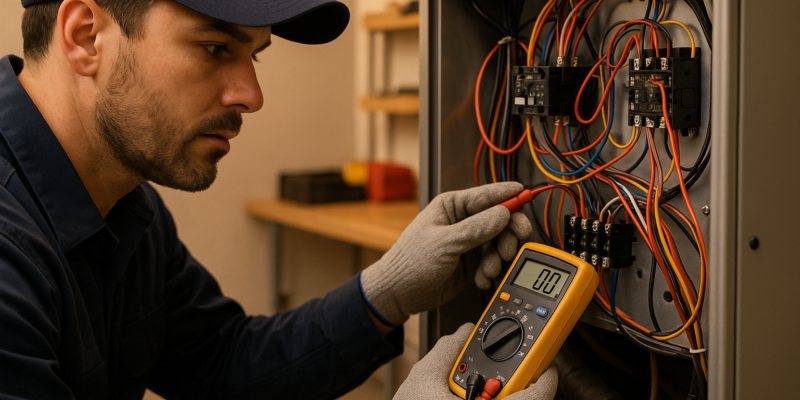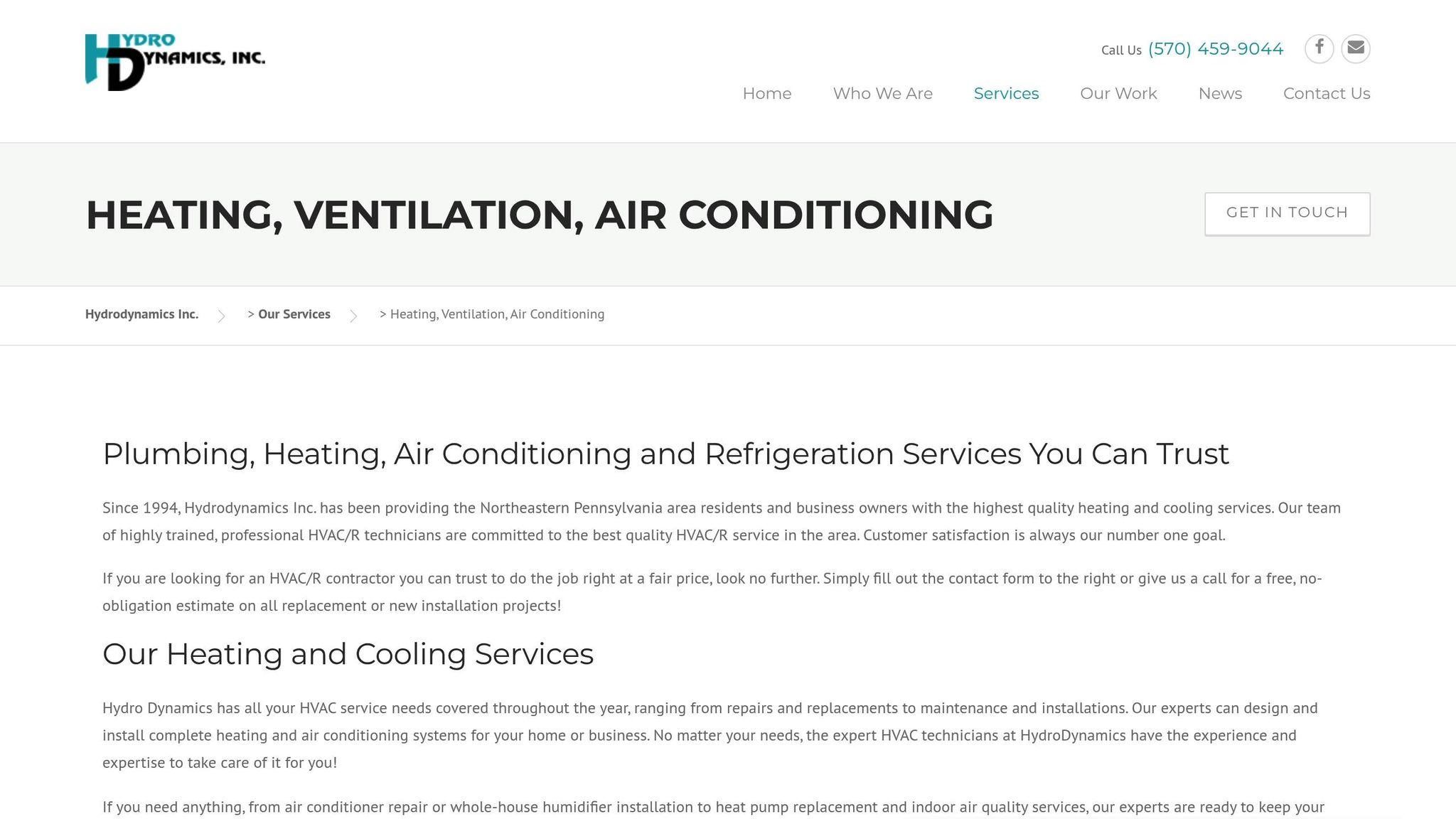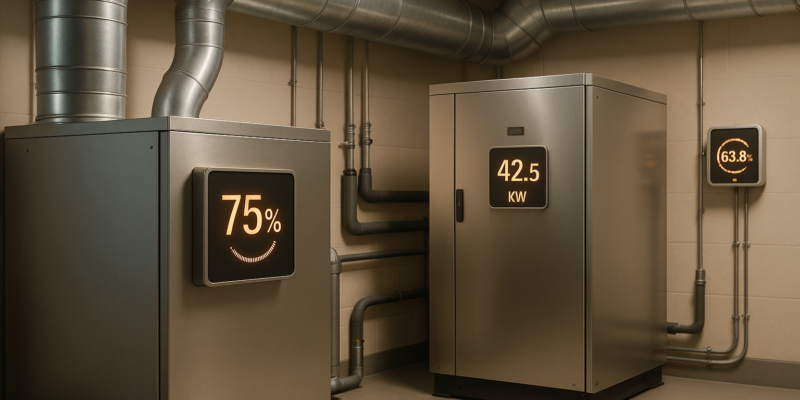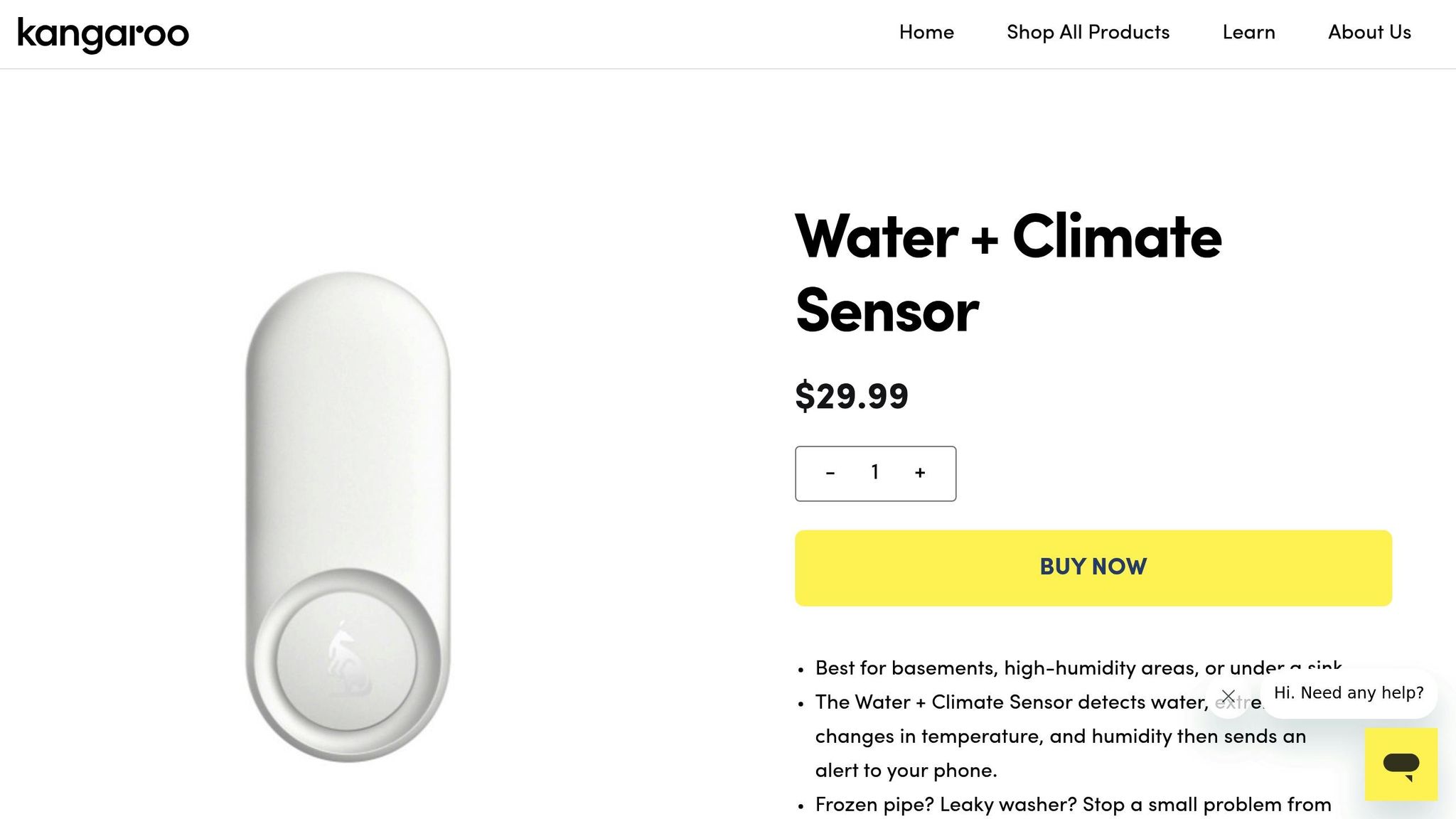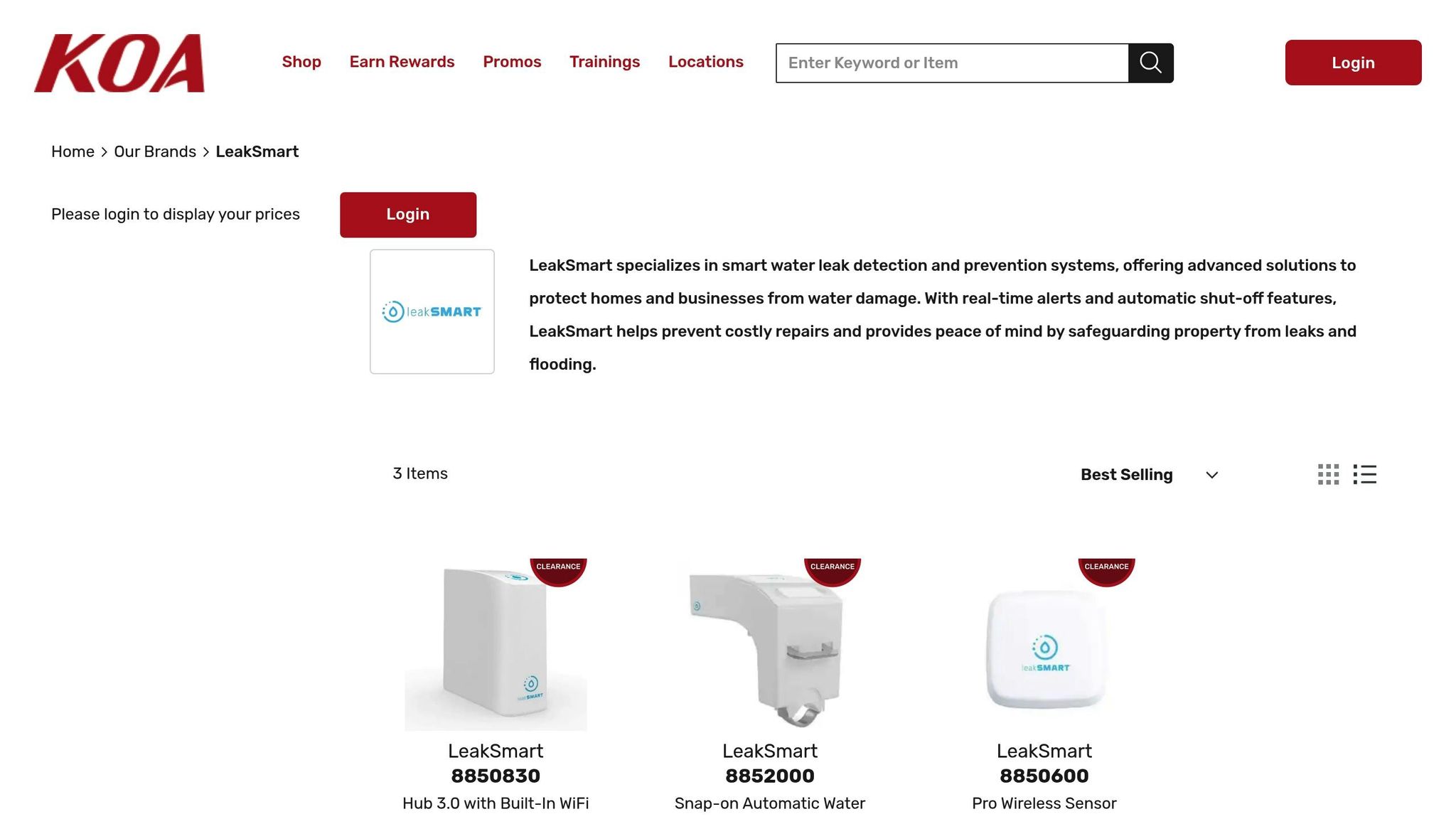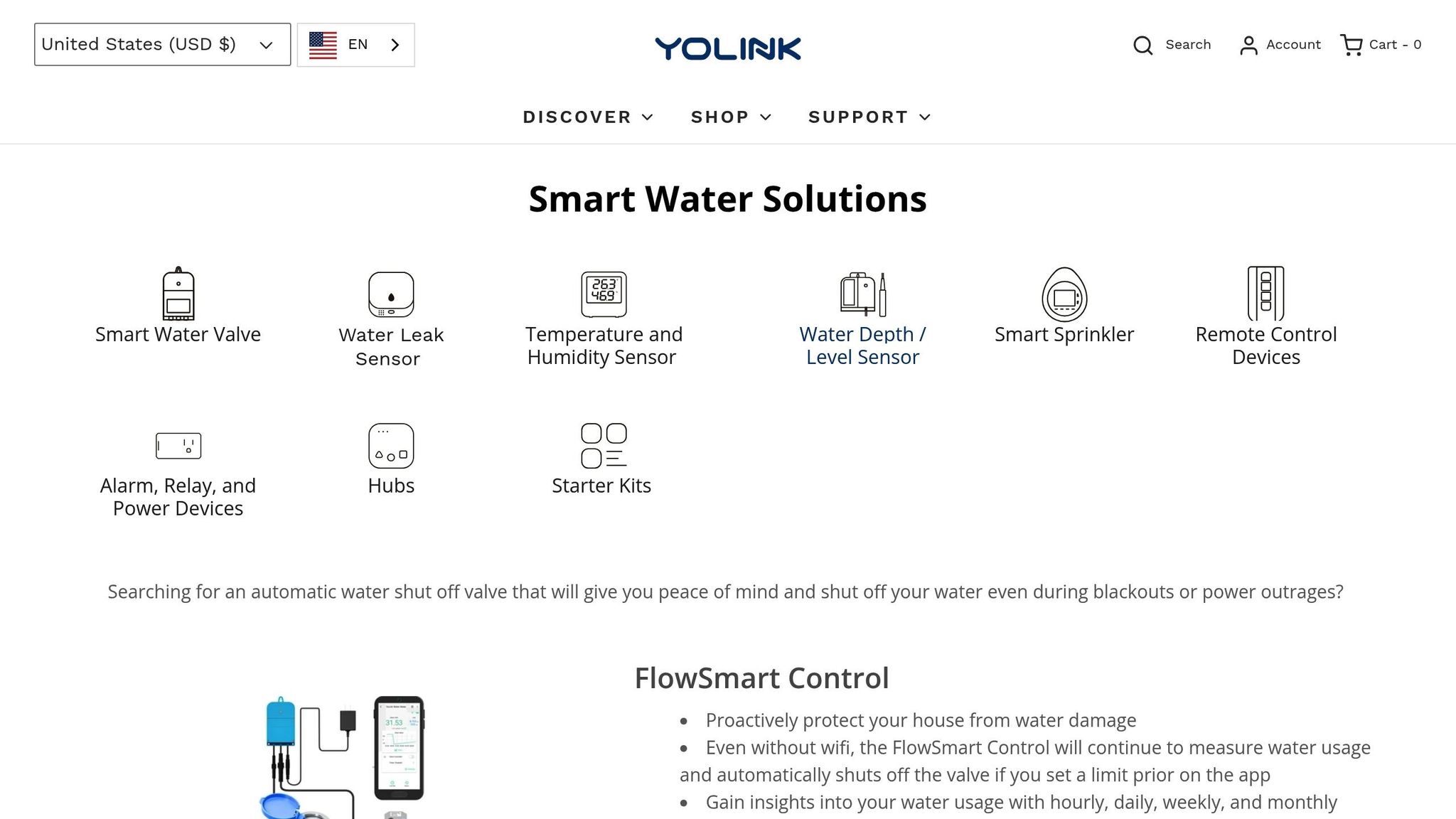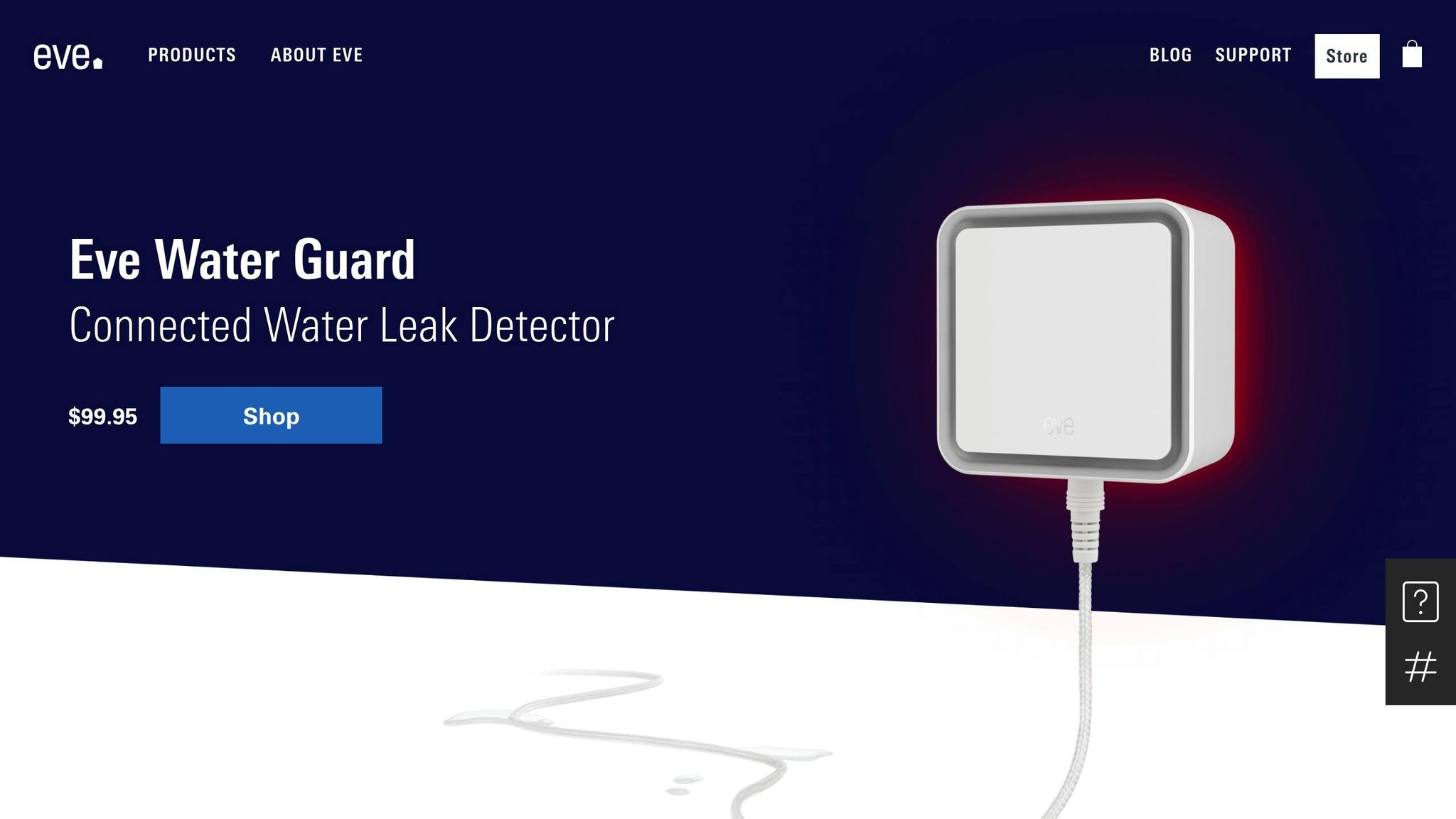How to Test HVAC Electrical Components
If your HVAC system isn’t working as it should, electrical components might be to blame. Testing these parts can help identify problems early, saving money and improving safety. Here’s the gist:
- Why Test?
Regular testing prevents breakdowns, extends system life by up to 40%, and reduces repair costs. Faulty components can also hike energy bills and pose safety risks like fires or gas leaks. - Safety First:
Always turn off power at the circuit breaker, use lockout/tagout procedures, and wear protective gear like insulated gloves and goggles. - Essential Tools:
Equip yourself with a multimeter, clamp meter, and non-contact voltage tester. Advanced tools like insulation resistance testers and carbon monoxide meters can also help. - What to Test:
Key components include capacitors, contactors, relays, fan motors, thermostats, pressure switches, transformers, and control boards. Check for common failure signs like bulging capacitors, corroded contactors, or blown fuses. - When to Call a Pro:
Issues like gas leaks, frequent circuit breaker trips, or refrigerant problems require expert help. DIY fixes can void warranties and lead to safety hazards.
Testing HVAC electrical components isn’t just about fixing problems – it’s about maintaining efficiency, cutting costs, and keeping your home safe. Follow proper procedures, use the right tools, and don’t hesitate to contact a professional if needed.
Electrical Troubleshooting! Finding 8 Electrical Faults!
Safety Precautions and Required Tools
Working with HVAC electrical systems comes with inherent risks. In the U.S., electrical accidents result in approximately 1,000 deaths and 30,000 injuries annually, while HVAC systems alone contribute to over 40,000 injuries each year. These numbers highlight the importance of following strict safety protocols and using the proper tools – not just for your own safety but for the well-being of everyone around you.
Basic Safety Guidelines
The first rule of safe HVAC electrical work is to completely shut off the power. Don’t just rely on equipment switches – turn off the power at the circuit breaker and confirm that the circuits are de-energized using a properly calibrated multimeter or voltage tester. Always verify your meter’s accuracy on a live circuit both before and after testing the work area.
Lockout/tagout procedures are a must for added protection. Secure the switch in the OFF position with a padlock, attach a tag with clear details, and post a sign warning others to keep the power off.
Personal protective equipment (PPE) serves as your last line of defense. Wear nonconductive gloves, insulated blankets, hoods, and a helmet when handling electrical components. Use only insulated tools, avoid standing in water, and ensure all electrical components are properly grounded before beginning any work. Regularly inspect wiring for damage, keep components dry, and adhere to NFPA 70E standards as well as local electrical codes to maintain safe working conditions.
Once these safety measures are in place, you’ll need the right tools to carry out accurate and effective HVAC electrical testing.
Tools for HVAC Electrical Testing
Having the right tools is essential for precise HVAC electrical diagnostics. Here are some of the key instruments every technician should have:
- Digital multimeters: These are the cornerstone of electrical testing. For example, the Fluke 116 Digital HVAC Multimeter ($274.99) measures voltage, current, and resistance, and includes features like temperature and microamp functions for flame sensor testing.
- Clamp meters: These allow you to measure current safely without breaking the circuit. The Fluke 902 FC True-RMS HVAC Clamp Meter ($389.99) offers wireless connectivity and specialized HVAC functions. Look for models with built-in test lead holders for added convenience.
- Insulation resistance testers: These devices detect deteriorating wire insulation before it causes failures. The Fluke 1587 FC Insulation Multimeter ($1,038.99) combines insulation testing with standard multimeter capabilities, making it a versatile tool for comprehensive diagnostics.
- Non-contact voltage testers: These provide a quick and safe way to check if a circuit is live by detecting electrical fields without direct contact. For extra safety, use test leads with finger barriers.
- Residual Current Devices (RCDs): These devices add an extra layer of protection by automatically cutting power when a ground fault occurs.
In addition to these tools, safety devices play a crucial role during testing:
| Safety Device | Function | Action Required |
|---|---|---|
| Circuit Breaker | Trips automatically during overcurrent | Resettable |
| Fuse | Melts to interrupt overcurrent | Replaceable |
| GFCI | Trips when a ground fault is detected | Resettable |
For more advanced diagnostics, consider tools like the Fluke 971 Temperature Humidity Meter ($503.99), which helps assess environmental factors affecting electrical components, and the Fluke CO-220 Carbon Monoxide Meter ($712.99), which ensures safe conditions around combustion equipment.
Always use factory-approved parts to maintain safety standards and ensure reliable performance. Additionally, keep your tools calibrated and in good working order – faulty equipment can lead to inaccurate readings and dangerous situations.
Common HVAC Electrical Components to Test
Knowing the electrical components in your HVAC system is essential for proper testing and maintenance. These parts work together to keep your system running smoothly, and identifying issues early can save you from costly repairs. Below, we’ll break down the key components you should be testing and the signs they might be failing.
Overview of Standard Components
Capacitors are vital for powering motors by storing and releasing energy as needed. However, they can fail due to heat, age, or voltage spikes. Signs of a failing capacitor include a bulging case, oil leakage, or a motor that “growls” but won’t start.
Contactors act as heavy-duty switches, controlling the power flow to your system’s compressor and fan motors. When contactors develop pitting or corrosion on their contact points, they can disrupt electrical flow, leading to system malfunctions.
Relays handle the timing of electrical circuits, ensuring everything runs in sync. A failing relay might cause cooling issues, unusual odors, or odd noises from the system.
Fan motors are responsible for circulating air throughout your home to maintain comfort. They depend on capacitors to function correctly. If a fan motor struggles or fails to start, it could signal capacitor problems or internal motor issues that need immediate attention.
Thermostats monitor and regulate indoor temperatures. If your thermostat is giving incorrect readings or causing frequent cycling, it may be malfunctioning.
Pressure switches are critical safety devices that monitor refrigeration pressure and protect the compressor. They shut down the system when pressure exceeds safe limits, preventing expensive compressor damage.
Transformers adjust the voltage of your electrical supply to meet the needs of various components. Most HVAC systems use transformers to step down household voltage from 240V to 24V for control circuits. A failed transformer can cause the entire control system to stop working.
The control board acts as the command center, coordinating all electrical components. As Topline Heating & Air explains:
“The HVAC Control board coordinates the activity of the electrical components of your heating and air conditioning systems. It receives signals from the thermostat and turns the furnace and air conditioning on at appropriate times to keep the interior air at the temperature you want.”
Other key elements include fuses, switches, and sensors. Fuses protect circuits from overcurrent and will shut down the system if they blow. Sensors monitor system conditions and send data to the control board.
| Component | Primary Function | Common Failure Signs |
|---|---|---|
| Capacitors | Start and run motors | Bulging case, oil leakage, motor won’t start |
| Contactors | Control power flow | Pitting, corrosion, system won’t turn on |
| Relays | Circuit timing control | Compressor issues, inconsistent cooling |
| Thermostats | Temperature control | Incorrect readings, frequent cycling |
| Transformers | Voltage conversion | No power to control circuits |
Understanding these components and their typical failure signs can make diagnosing HVAC issues more efficient. By pinpointing the likely problem areas, you can streamline your testing process and address issues before they escalate.
Step-by-Step Testing Guide
After setting up safety protocols and tools, it’s time to dive into the hands-on steps for testing electrical components. Always ensure the power is disconnected and locked out at the main source. Before starting, verify the circuit is de-energized using a voltmeter for added safety.
Testing Switches and Relays
When it comes to switches and contactors, continuity testing is your go-to method. A closed switch or contactor should show very low resistance – typically under 1 ohm – indicating a complete circuit. For multi-pole devices, all legs should provide consistent readings.
Here’s how to test switches and contactors:
- Manually activate the component.
- Set your multimeter to ohms or resistance mode.
- Place the meter leads on the appropriate terminals and test each pole.
- Record the readings. Low, consistent values suggest proper operation, while high or irregular readings may point to pitted contacts, loose connections, mechanical issues, or oxidation.
“Continuity testing is a crucial diagnostic skill that can save you hours of troubleshooting and prevent recurring system failures.”
For relays, especially electronic ones like those in Trane AC units, follow these additional steps:
- Consult the service manual and relay datasheet for specific instructions.
- Inspect for physical damage, corrosion, or signs of overheating.
- Measure the coil resistance and compare it to the datasheet specifications.
- Test contact continuity in the de-energized state.
- Apply the correct control voltage to the coil and recheck contact continuity.
- Check insulation resistance between the coil and contact circuitry.
For coil relays, verify that normally open (NO) contacts show infinite resistance and normally closed (NC) contacts show 0 ohms when de-energized, following manufacturer specifications. After energizing the relay with an independent voltage source, NO contacts should read near 0 ohms, while NC contacts should show infinite resistance.
Once switches and relays are tested, move on to motors and compressors, where physical inspections and winding tests are essential.
Testing Motors and Compressors
Before testing motor or compressor components, ensure the unit’s power is off and all capacitors are fully discharged.
Safety Tip: Always wear protective gear, such as gloves and goggles, during motor testing.
Start with a visual inspection. Look for signs of wear, rust, or damage, and clean the terminals to ensure accurate winding resistance measurements. Melted lugs or damaged plugs might indicate high current, loose connections, or moisture issues.
For winding resistance tests:
- Use a multimeter to measure motor winding resistance. In healthy three-phase motors, all wire pairs should have matching resistance values. Uneven readings could signal winding problems.
- Perform insulation resistance testing (IRT) by applying DC voltage to the windings. This helps detect leakage currents and assess motor health. Adjust readings for temperature variations.
For instance, in 2022, a scroll compressor showed 2.7 ohms resistance from windings to ground and about 2.6 kilo-ohms between winding pairs – indicating it was close to failure. Always check for shorts to ground; an “infinite” reading means the resistance exceeds the meter’s range.
Testing Capacitors
Capacitors require both capacitance and resistance tests. Always discharge the capacitor completely by shorting its terminals with an insulated tool before testing.
- Switch your multimeter to capacitance mode, connect the leads to the capacitor terminals, and check if the value is within 10% of the rated capacitance.
- Alternatively, use resistance mode. A functioning capacitor will initially show low resistance, which gradually increases as it charges. If the resistance remains low, the capacitor may be shorted; if it jumps to infinite resistance right away, the circuit could be open.
- Inspect for physical damage, such as bulging, oil leaks, or burn marks.
After confirming the capacitor’s condition, move on to test fuses and transformers to ensure the circuit is safe.
Testing Fuses and Transformers
For fuses:
- Set your multimeter to continuity or low-resistance mode and test across the fuse terminals.
- A working fuse will show near-zero resistance, while a blown fuse will display infinite resistance or no continuity.
- Check for visible signs of damage, such as darkened glass or burn marks, and replace with a fuse of the same amperage rating.
For transformers:
- Disconnect power and measure the resistance of the primary and secondary windings. HVAC transformers typically step down from 240V to 24V.
- Perform insulation testing between windings and between windings and ground, using the highest resistance range to check for potential shorts.
Regular testing during maintenance, service calls, or after electrical storms can identify problems early, preventing system failures or safety hazards.
sbb-itb-99db659
Reading Test Results and Troubleshooting
Understanding test results is just as important as performing the tests themselves. Once you’ve mastered the testing process, analyzing the data ensures your HVAC system operates both safely and efficiently. The ability to distinguish between normal and faulty readings can mean the difference between smooth operation and unexpected breakdowns.
Normal vs. Faulty Readings
Continuity and resistance readings are key indicators of a component’s health. For switches and contactors, properly functioning components should have low resistance readings – typically under 1 ohm. This shows there’s a complete electrical path with minimal resistance, allowing current to flow freely.
When testing fuses, a healthy fuse will show continuity across its terminals. A blown fuse, on the other hand, will display infinite resistance or no continuity at all.
High or inconsistent resistance readings often point to issues like pitted contacts, loose connections, mechanical failures, or contamination on contact surfaces.
Capacitance readings are another critical metric. These should stay within 10% of the rated value printed on the component. Any deviation beyond this range is a red flag.
It’s also important to account for temperature’s impact on readings, especially when performing insulation resistance tests on motors. Ambient conditions can skew results, so adjusting for temperature ensures accurate evaluations of component health. These benchmarks are essential for pinpointing faults during troubleshooting.
Common HVAC Component Failures
Once you’ve gathered your test results, they can help identify common failure patterns across HVAC components. Familiarity with these signs can streamline the troubleshooting process and lead to quicker diagnoses.
| Component | Common Signs of Failure |
|---|---|
| Capacitors | Bulging, leakage, capacitance out of spec |
| Contactors | Pitting, corrosion, inconsistent continuity |
| Relays | No continuity, abnormal coil resistance |
Capacitor failures are often easy to spot. Look for physical damage like bulging, oil leaks, or capacitance values that fall outside the acceptable 10% range.
Contactors and switches tend to fail due to contact degradation. For example, on May 8, 2025, a technician identified a rooftop unit issue caused by inconsistent resistance readings across a disconnect switch. This problem was blowing fuses repeatedly. By checking continuity, the technician discovered the switch wasn’t making proper contact on all phases. Replacing both the damaged motor and the faulty switch permanently resolved the issue.
Motor and compressor failures can be identified by uneven winding resistance in three-phase units. In a healthy motor, all wire pairs should have matching resistance values. Uneven readings often signal winding problems, which, if left unchecked, can lead to complete failure.
Transformer failures typically involve problems with the windings. Open windings will show infinite resistance, while shorted windings will have abnormally low resistance. Insulation breakdown – whether between windings or from windings to ground – poses a serious safety risk and requires immediate replacement.
Circuit breaker issues are another common problem. Frequent tripping can indicate system overloads or downstream component failures. A breaker that won’t reset or shows signs of burning needs to be addressed right away.
For accurate troubleshooting, always compare your readings to manufacturer specifications rather than relying on general benchmarks. Each component has specific tolerances, and staying within these ensures dependable performance. Documenting your findings can also help monitor wear and anticipate future maintenance needs.
Finally, don’t overlook the obvious. Unusual noises, burning smells, or visible damage often accompany electrical failures. Relying on all your senses during troubleshooting can reveal problems that might not show up in your electrical tests.
When to Contact Professional HVAC Services
After conducting your initial troubleshooting, it’s essential to recognize the signs that indicate the need for professional HVAC assistance. While DIY efforts can help you understand your system and potentially save money, some problems require expert attention to ensure safety and protect your investment. Here’s when it’s time to call in the pros.
Situations Requiring Professional Help
Gas Leaks
The smell of rotten eggs is a telltale sign of a gas leak. If you notice this, shut off your system immediately and contact a professional. Gas leaks pose serious safety risks, including fire hazards and exposure to carbon monoxide.
Frequent Circuit Breaker Trips
If your circuit breaker keeps tripping, it’s likely more than a simple reset issue. This could indicate deeper electrical problems that require professional diagnosis and repair.
Major Electrical Failures
For gas-powered HVAC systems, attempting DIY electrical repairs can be dangerous. Not only could it void your warranty, but it also increases the risk of injury.
Persistent Malfunctions or Strange Noises
If your HVAC system continues to malfunction or makes unusual noises – even after you’ve checked the thermostat, air filters, circuit breakers, and vents, and tried resetting the system – it’s time to call an expert.
Refrigerant Leaks, Faulty Compressors, or Damaged Heating Elements
These issues demand specialized tools and expertise to handle safely. Professional technicians are equipped to diagnose and repair these complex components.
DIY electrical repairs can be particularly hazardous. According to OSHA, around 187 electrical-related fatalities occur annually. Attempting to fix HVAC issues on your own could lead to electrical shocks, electrocution, fire risks, or carbon monoxide exposure. Additionally, improper repairs might damage costly components and void your system’s warranty.
“Your heating, ventilation, and air conditioning system is a complex network of electrical components, chemicals, and mechanical parts that requires specialized knowledge and tools for safe handling.”
Hydrodynamics: Your Trusted HVAC Partner
When faced with these challenges, professional expertise is essential. Hydrodynamics Inc., a family-owned business with over 30 years of experience, specializes in HVAC diagnostics, repairs, and maintenance for residential, commercial, and industrial clients across Pennsylvania.
Hydrodynamics’ certified technicians bring the expertise needed for safe and effective electrical work. They are trained in refrigeration principles, heating systems, and electrical diagnostics. Their focus on safety is evident in their adherence to strict protocols, use of Personal Protective Equipment (PPE), and compliance with manufacturer recommendations.
Beyond repairs, Hydrodynamics offers preventive maintenance programs designed to reduce costly breakdowns and extend the life of your HVAC system. These programs include detailed service logs and follow manufacturer guidelines to ensure optimal performance.
“Professional technicians are equipped with the knowledge and tools to safely manage these risks.”
- Efficient Systems Heating & Air Conditioning
Using advanced diagnostic tools and following strict manufacturer guidelines, Hydrodynamics ensures your system remains under warranty and operates safely. If your troubleshooting efforts don’t resolve the issue, or if you encounter serious electrical problems, their team is ready to restore your system efficiently and safely.
Conclusion
Testing isn’t just a technical step – it’s a critical one. It saves time, cuts costs, and keeps systems running smoothly. Skipping it can lead to inefficiencies and even dangerous situations.
Always prioritize safety. Before testing, ensure the power is off at the source, use lockout/tagout procedures, and double-check that the system is de-energized. Electrical accidents are no small matter, with around 1,000 fatalities and 30,000 injuries reported annually in the U.S.. These precautions aren’t optional – they’re lifesaving.
Regular maintenance and testing also go a long way in preventing small issues from snowballing into expensive repairs. For instance, something as simple as cleaning air filters can cut energy consumption by up to 15%. Similarly, routine checks on electrical components can catch problems early, avoiding costly system failures.
Know your limits, though. While a multimeter can help troubleshoot many basic issues, complex electrical problems demand professional expertise. If you’re not fully qualified, don’t attempt repairs – leave it to the experts.
For those in Pennsylvania, Hydrodynamics Inc. is a trusted name in electrical diagnostics. Since 1994, this family-owned business has been offering certified technicians, strict safety standards, and preventive maintenance programs to keep systems running safely and efficiently.
FAQs
What are the warning signs that my HVAC system’s electrical components need testing?
If your HVAC system starts making odd sounds – like buzzing, humming, or clicking – it might be pointing to electrical issues. You might also notice other red flags, such as the system failing to turn on, struggling to keep performance steady, or shutting down unexpectedly. These problems often trace back to faulty parts like capacitors, relays, or contactors.
To avoid bigger headaches down the road, it’s smart to include testing your system’s electrical components in your annual maintenance routine. And if you notice anything unusual, don’t wait – addressing these issues promptly helps keep your HVAC system running smoothly and safely.
What steps should I take to safely test HVAC electrical components?
To test HVAC electrical components safely, the first step is to turn off the power to the system. Always follow lockout/tagout procedures to avoid accidental re-energization. This is crucial for preventing unexpected electrical hazards.
Make sure to use insulated tools and wear appropriate protective gear, including insulated gloves, safety goggles, and protective clothing. These measures greatly reduce the chances of electrical shock or injury.
Before testing, take a moment to inspect the components for any visible damage and confirm proper grounding. When you’re ready to test, use a multimeter and carefully follow the manufacturer’s instructions for each component. These steps are essential for maintaining safety while working with electrical systems.
When is it best to call a professional for HVAC electrical issues instead of fixing them yourself?
If you’re dealing with safety concerns like sparking, burning smells, strange noises, or visible damage to electrical parts, it’s best to leave it to a professional. Trying to fix these issues without the right skills can be risky.
Signs like frequent circuit trips, inconsistent performance, or odd odors often point to deeper problems that require expert attention. Trained technicians have the equipment and expertise to handle these situations safely, ensuring the problem is resolved without causing further damage or creating additional risks.

